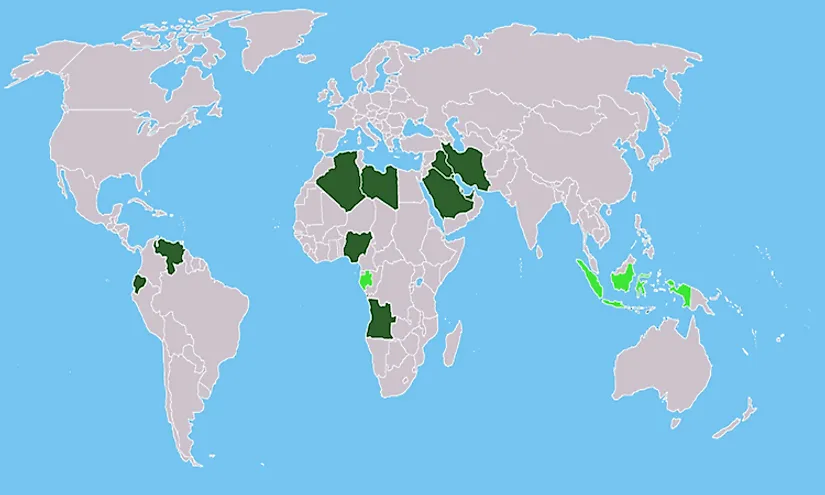OPEC Countries

What is OPEC?
OPEC is an acronym which stands for Organization of the Petroleum Exporting Countries. It is an organization that unites the governments of 14 developing and oil producing nations, which have banded together to gain more control of the global oil market. Their aim is to unify and coordinate petroleum policies of its members. The organization has a secretariat which is the executive organ of the OPEC, and its location is in Vienna, it also serves as the headquarters. The Secretariat is responsible for implementing resolutions and decisions made by the board of directors. It is in charge of carrying out research, and its findings form the basis of decision making.
OPEC Countries
In 2015, the 14 OPEC countries controlled 43% of the oil produced and 73% of oil reserves in the world. In 2014, the US was leading globally in oil production, though it is not an OPEC member. The second largest producer was Saudi Arabia, which is an OPEC member state. Other large producers include Russia, China, Canada, and UAE. Out of the above oil-rich countries, only UAE is an OPEC member. Petroleum is a valuable resource to industries and is crucial to the maintenance of the modern industrialized world; for these reasons the world follows keenly the events that take place in the oil market. Oil accounts for a great percentage of global energy consumption and it is consumed mostly by developed nations.
Formation Of OPEC
OPEC was established in 1960 in Baghdad by the first five members: Saudi Arabia, Venezuela, Iraq, Kuwait, and Iran. Since 1965, OPEC’s headquarters have been in Vienna, Austria. The formation of OPEC signified that the time when nations would have exclusive sovereignty over their natural resources was coming to an end; more and more nations were uniting in economic blocs and trade pacts. OPEC’s decisions have had a significant impact on the global oil market and in international affairs, for instance, conflicts in member states have lead to interrupted supply of oil. In the 1970s restrictions were placed on oil production; this led to a sharp increase in prices of Oil, raising OPEC revenue and wealth in similarly dramatic manner, events which had significant consequences for the global economy. In the 1980s, the organization began to set production targets for its member states. When the targets are low, the price of oil rises.
Mission Of OPEC
OPEC's mission is to unify and coordinate the policies of its member states that concern petroleum, to ensure oil markets are stabilized, with the intention of securing efficient, economical and regular petroleum supply for consumers, a steady income for producers, and a fair return on capital for investors in the industry.
OPEC Member States
OPEC has 14 member states. They are Indonesia whose oil production in 2015 was 786,000 bbl/day; Nigeria at 2,317,000 bbl/day; Iran at 3,300,000 bbl/day; Algeria at 1.370,000 bbl/day’ Iraq at 4,054,000 bbl/day; Venezuela at 2,500,000 bbl/day; Saudi Arabia at 10,046,000 bbl/day; Angola at 1.842,000 bbl/day; Ecuador at 543,000 bbl/day; Libya at 404,000 bbl/day; United Arab Emirates at 2,820,000 bbl/day; Kuwait at 2,562,000 bbl/day; Qatar at 1,562,000 bbl/day; and Gabon at 213,000 bbl/day.
Administration And Management Of OPEC
The supreme authority of the organization is the OPEC Conference, which comprises delegations headed by the oil ministers of the member states. The secretary general of OPEC is the chief executive. The Conference holds meetings at OPEC’s headquarters in Vienna at least twice each year; extraordinary sessions are also held when necessary. The OPEC operates on principles of unanimity, with each member state having one vote and paying an equal membership fee into the annual budget.
Future Prospects
In 2015, Sudan formally applied to join OPEC, and its approval is still pending. Approval of a new member country is a process; it requires three-fourths of the existing members to agree, including all five founder states. Recently production of oil in the United States has been on the rise, catapulting it to the leading position, slightly ahead of Saudi Arabia at 11,973000 bbl/day in 2014 to Saudi Arabia’s 11,624,000 bbl/day. As the green movement gains prominence and crude oil deposits continue to deplete, the world is in search of alternative sources of energy; among this is the nuclear power. However, until that happens, and oil is still the energy source of choice, OPEC countries will continue to flourish and dominate oil production.
OPEC Countries
| Rank | Country | Population (2015 est.) | Area (km²) | Oil Production (bbl/day, 2015) | Proven Reserves (bbl, 2015)[ |
|---|---|---|---|---|---|
| 1 | Indonesia | 255,993,674 | 1,904,569 | 786,000 | 3,690,000,000 |
| 2 | Nigeria | 181,562,056 | 923,768 | 2,317,000 | 37,070,000,000 |
| 3 | Iran | 81,824,270 | 1,648,000 | 3,300,000 | 157,800,000,000 |
| 4 | Algeria | 39,542,166 | 2,381,740 | 1,370,000 | 12,200,000,000 |
| 5 | Iraq | 37,056,169 | 437,072 | 4,054,000 | 144,200,000,000 |
| 6 | Venezuela | 29,275,460 | 912,050 | 2,500,000 | 298,350,000,000 |
| 7 | Saudi Arabia | 27,752,316 | 2,149,690 | 10,046,000 | 268,290,000,000 |
| 8 | Angola | 19,625,353 | 1,246,700 | 1,842,000 | 9,010,000,000 |
| 9 | Ecuador | 15,868,396 | 283,560 | 543,000 | 8,830,000,000 |
| 10 | Libya | 6,411,776 | 1,759,540 | 404,000 | 48,360,000,000 |
| 11 | United Arab Emirates | 5,779,760 | 83,600 | 2,820,000 | 97,800,000,000 |
| 12 | Kuwait | 2,788,534 | 17,820 | 2,562,000 | 104,000,000,000 |
| 13 | Qatar | 2,194,817 | 11,437 | 1,532,000 | 25,240,000,000 |
| 14 | Gabon | 1,705,336 | 267,667 | 213,000 | 2,000,000,000 |











